- Home
- Edgar Allan Poe
The Science Fiction of Edgar Allan Poe (Penguin Classics) Page 31
The Science Fiction of Edgar Allan Poe (Penguin Classics) Read online
Page 31
By the time the Sun had shrunk until it occupied a space just that circumscribed by the orbit of Saturn, the balance, we are to suppose, between its centripetal and centrifugal forces had again become so far disturbed, through increase of rotary velocity, the result of condensation, that a third effort at equilibrium became necessary; and an annular band was therefore whirled off, as twice before; which, on rupture through ununiformity, became consolidated into the planet Saturn. This latter threw off, in the first place, seven ununiform bands, which, on rupture, were spherified respectively into as many moons; but, subsequently, it appears to have discharged, at three distinct but not very distant epochs, three rings whose equability of constitution was, by apparent accident, so considerable as to present no occasion for their rupture; thus they continue to revolve as rings. I use the phrase ‘apparent accident’; for of accident in the ordinary sense there was, of course, nothing: – the term is properly applied only to the result of indistinguishable or not immediately traceable law.
Shrinking still farther, until it occupied just the space circumscribed by the orbit of Jupiter, the Sun now found need of farther effort to restore the counterbalance of its two forces, continually disarranged in the still continued increase of rotation. Jupiter, accordingly, was now thrown off; passing from the annular to the planetary condition; and, on attaining this latter, threw off in its turn, at four different epochs, four rings, which finally resolved themselves into so many moons.
Still shrinking, until its sphere occupied just the space defined by the orbit of the Asteroids, the Sun now discarded a ring which appears to have had nine centres of superior solidity, and, on breaking up, to have separated into nine fragments no one of which so far predominated in mass as to absorb the others.* All therefore, as distinct although comparatively small planets, proceeded to revolve in orbits whose distances, each from each, may be considered as in some degree the measure of the force which drove them asunder: – all the orbits, nevertheless, being so closely coincident as to admit of our calling them one, in view of the other planetary orbits.
Continuing to shrink, the Sun, on becoming so small as just to fill the orbit of Mars, now discharged this planet – of course by the process repeatedly described. Since he has no moon, however, Mars could have thrown off no ring. In fact, an epoch had now arrived in the career of the parent body, the centre of the system. The decrease of its nebulosity, which is the increase of its density, and which again is the decrease of its condensation, out of which latter arose the constant disturbance of equilibrium – must, by this period, have attained a point at which the efforts for restoration would have been more and more ineffectual just in proportion as they were less frequently needed. Thus the processes of which we have been speaking would everywhere show signs of exhaustion – in the planets, first, and secondly, in the original mass. We must not fall into the error of supposing the decrease of interval observed among the planets as we approach the Sun, to be in any respect indicative of an increase of frequency in the periods at which they were discarded. Exactly the converse is to be understood. The longest interval of time must have occurred between the discharges of the two interior; the shortest, between those of the two exterior, planets. The decrease of the interval of space is, nevertheless, the measure of the density, and thus inversely of the condensation, of the Sun, throughout the processes detailed.
Having shrunk, however, so far as to fill only the orbit of our Earth, the parent sphere whirled from itself still one other body – the Earth – in a condition so nebulous as to admit of this body’s discarding, in its turn, yet another, which is our Moon; – but here terminated the lunar formations.
Finally, subsiding to the orbits first of Venus and then of Mercury, the Sun discarded these two interior planets; neither of which has given birth to any moon.
Thus from his original bulk – or, to speak more accurately, from the condition in which we first considered him – from a partially spherified nebular mass, certainly much more than 5,600 millions of miles in diameter – the great central orb and origin of our solar-planetary-lunar system, has gradually descended, by condensation, in obedience to the law of Gravity, to a globe only 882,000 miles in diameter; but it by no means follows, either that its condensation is yet complete, or that it may not still possess the capacity of whirling from itself another planet.
I have here given – in outline of course, but still with all the detail necessary for distinctness – a view of the Nebular Theory as its author himself conceived it. From whatever point we regard it, we shall find it beautifully true. It is by far too beautiful, indeed, not to possess Truth 31 as its essentiality – and here I am very profoundly serious in what I say. In the revolution of the satellites of Uranus, there does appear something seemingly inconsistent with the assumptions of Laplace; but that one inconsistency can invalidate a theory constructed from a million of intricate consistencies, is a fancy fit only for the fantastic. In prophecying, confidently, that the apparent anomaly to which I refer, will, sooner or later, be found one of the strongest possible corroborations of the general hypothesis, I pretend to no especial spirit of divination. It is a matter which the only difficulty seems not to foresee.*
The bodies whirled off in the processes described, would exchange, it has been seen, the superficial rotation of the orbs whence they originated, for a revolution of equal velocity about these orbs as distant centres; and the revolution thus engendered must proceed, so long as the centripetal force, or that with which the discarded body gravitates toward its parent, is neither greater nor less than that by which it was discarded; that is, than the centrifugal, or, far more properly, than the tangential, velocity. From the unity, however, of the origin of these two forces, we might have expected to find them as they are found – the one accurately counterbalancing the other. It has been shown, indeed, that the act of whirling-off is, in every case, merely an act for the preservation of the counterbalance.
After referring, however, the centripetal force to the omniprevalent law of Gravity, it has been the fashion with astronomical treatises, to seek beyond the limits of mere Nature – that is to say, of Secondary Cause – a solution of the phænomenon of tangential velocity. This latter they attribute directly to a First Cause – to God. The force which carries a stellar body around its primary they assert to have originated in an impulse given immediately by the finger – this is the childish phraseology employed – by the finger of Deity itself. In this view, the planets, fully formed, are conceived to have been hurled from the Divine hand, to a position in the vicinity of the suns, with an impetus mathematically adapted to the masses, or attractive capacities, of the suns themselves. An idea so grossly unphilosophical, although so supinely adopted, could have arisen only from the difficulty of otherwise accounting for the absolutely accurate adaptation, each to each, of two forces so seemingly independent, one of the other, as are the gravitating and tangential. But it should be remembered that, for a long time, the coincidence between the moon’s rotation and her sidereal revolution – two matters seemingly far more independent than those now considered – was looked upon as positively miraculous; and there was a strong disposition, even among astronomers, to attribute the marvel to the direct and continual agency of God – who, in this case, it was said, had found it necessary to interpose, specially, among his general laws, a set of subsidiary regulations, for the purpose of forever concealing from mortal eyes the glories, or perhaps the horrors, of the other side of the Moon – of that mysterious hemisphere which has always avoided, and must perpetually avoid, the telescopic scrutiny of mankind. The advance of Science, however, soon demonstrated – what to the philosophical instinct needed no demonstration – that the one movement is but a portion – something more, even, than a consequence – of the other.
For my part, I have no patience with fantasies at once so timorous, so idle, and so awkward. They belong to the veriest cowardice of thought. That Nature and the God of Nature are distinct, no thinking being can
long doubt. By the former we imply merely the laws of the latter. But with the very idea of God, omnipotent, omniscient, we entertain, also, the idea of the infallibility of his laws. With Him there being neither Past nor Future – with Him all being Now – do we not insult him in supposing his laws so contrived as not to provide for every possible contingency? – or, rather, what idea can we have of any possible contingency, except that it is at once a result and a manifestation of his laws? He who, divesting himself of prejudice, shall have the rare courage to think absolutely for himself, cannot fail to arrive, in the end, at the condensation of laws into Law – cannot fail of reaching the conclusion that each law of Nature is dependent at all points upon all other laws, and that all are but consequences of one primary exercise of the Divine Volition. Such is the principle of the Cosmogony which, with all necessary deference, I here venture to suggest and to maintain.
In this view, it will be seen that, dismissing as frivolous, and even impious, the fancy of the tangential force having been imparted to the planets immediately by ‘the finger of God’, I consider this force as originating in the rotation of the stars: – this rotation as brought about by the in-rushing of the primary atoms, towards their respective centres of aggregation: – this in-rushing as the consequence of the law of Gravity: – this law as but the mode in which is necessarily manifested the tendency of the atoms to return into imparticularity : – this tendency as but the inevitable rëaction of the first and most sublime of Acts – that act by which a God, self-existing and alone existing, became all things at once, through dint of his volition, while all things were thus constituted a portion of God.
The radical assumptions of this Discourse suggest to me, and in fact imply, certain important modifications of the Nebular Theory as given by Laplace. The efforts of the repulsive power I have considered as made for the purpose of preventing contact among the atoms, and thus as made in the ratio of the approach to contact – that is to say, in the ratio of condensation.* In other words, Electricity, with its involute phænomena, heat, light and magnetism, is to be understood as proceeding as condensation proceeds, and, of course, inversely as density proceeds, or the cessation to condense. Thus the Sun, in the process of its consolidation, must soon, in developing repulsion, have become excessively heated – incandescent: and we can perceive how the operation of discarding its rings must have been materially assisted by the slight encrustation of its surface consequent on cooling. Any common experiment shows us how readily a crust of the character suggested, is separated, through heterogeneity, from the interior mass. But, on every successive rejection of the crust, the new surface would appear incandescent as before; and the period at which it would again become so far encrusted as to be readily loosened and discharged, may well be imagined as exactly coincident with that at which a new effort would be needed, by the whole mass, to restore the equilibrium of its two forces, disarranged through condensation. In other words: – by the time the electric influence (Repulsion) has prepared the surface for rejection, we are to understand that the gravitating influence (Attraction) is precisely ready to reject it. Here, then, as everywhere, the Body and the Soul walk hand in hand.
These ideas are empirically confirmed at all points. Since condensation can never, in any body, be considered as absolutely at an end, we are warranted in anticipating that, whenever we have an opportunity of testing the matter, we shall find indications of resident luminosity in all the stellar bodies – moons and planets as well as suns. That our Moon is self-luminous,32 we see at her every total eclipse, when, if not so, she would disappear. On the dark part of the satellite, too, during her phases, we often observe flashes like our own Auroras; and that these latter, with our various other so-called electrical phænomena, without reference to any more steady radiance, must give our Earth a certain appearance of luminosity to an inhabitant of the Moon, is quite evident. In fact, we should regard all the phænomena referred to, as mere manifestations, in different moods and degrees, of the Earth’s feebly-continued condensation.
If my views are tenable, we should be prepared to find the newer planets – that is to say, those nearer the Sun – more luminous than those older and more remote : – and the extreme brilliancy of Venus (on whose dark portions, during her phases, the Auroras are frequently visible) does not seem to be altogether accounted for by her mere proximity to the central orb. She is no doubt vividly self-luminous, although less so than Mercury : while the luminosity of Neptune may be comparatively nothing.
Admitting what I have urged, it is clear that, from the moment of the Sun’s discarding a ring, there must be a continuous diminution both of his heat and light, on account of the continuous encrustation of his surface; and that a period would arrive – the period immediately previous to a new discharge – when a very material decrease of both light and heat, must become apparent. Now, we know that tokens of such changes are distinctly recognizable. On the Melville islands – to adduce merely one out of a hundred examples – we find traces of ultra-tropical vegetation33 – of plants that never could have flourished without immensely more light and heat than are at present afforded by our Sun to any portion of the surface of the Earth. Is such vegetation referable to an epoch immediately subsequent to the whirling-off of Venus? At this epoch must have occurred to us our greatest access of solar influence; and, in fact, this influence must then have attained its maximum : – leaving out of view, of course, the period when the Earth itself was discarded – the period of its mere organization.
Again: – we know that there exist non-luminous suns – that is to say, suns whose existence we determine through the movements of others, but whose luminosity is not sufficient to impress us. Are these suns invisible merely on account of the length of time elapsed since their discharge of a planet? And yet again: – may we not – at least in certain cases – account for the sudden appearances of suns where none had been previously suspected, by the hypothesis that, having rolled with encrusted surfaces throughout the few thousand years of our astronomical history, each of these suns, in whirling off a new secondary, has at length been enabled to display the glories of its still incandescent interior? – To the well-ascertained fact of the proportional increase of heat as we descend into the Earth, I need of course, do nothing more than refer : – it comes in the strongest possible corroboration of all that I have said on the topic now at issue.
In speaking, not long ago, of the repulsive or electrical influence, I remarked that ‘the important phænomena of vitality, consciousness, and thought, whether we observe them generally or in detail, seem to proceed at least in the ratio of the heterogeneous’.* I mentioned, too, that I would recur to the suggestion : – and this is the proper point at which to do so. Looking at the matter, first, in detail, we perceive that not merely the manifestation of vitality, but its importance, consequences, and elevation of character, keep pace, very closely, with the heterogeneity, or complexity, of the animal structure. Looking at the question, now, in its generality, and referring to the first movements of the atoms towards mass-constitution, we find that heterogeneousness, brought about directly through condensation, is proportional with it forever. We thus reach the proposition that the importance of the development of the terrestrial vitality proceeds equably with the terrestrial condensation.
Now this is in accordance with what we know of the succession of animals on the Earth. As it has proceeded in its condensation, superior and still superior races have appeared. Is it impossible that the successive geological revolutions which have attended, at least, if not immediately caused, these successive elevations of vitalic character – is it improbable that these revolutions have themselves been produced by the successive planetary discharges from the Sun – in other words, by the successive varia tions in the solar influence on the Earth? Were this idea tenable, we should not be unwarranted in the fancy that the discharge of yet a new planet, interior to Mercury, may give rise to yet a new modification of the terrestrial surface – a modification fro
m which may spring a race both materially and spiritually superior to Man. These thoughts impress me with all the force of truth – but I throw them out, of course, merely in their obvious character of suggestion.
The Nebular Theory of Laplace has lately received far more confirmation than it needed, at the hands of the philosopher, Comte.34 These two have thus together shown – not, to be sure, that Matter at any period actually existed as described, in a state of nebular diffusion, but that, admitting it so to have existed throughout the space and much beyond the space now occupied by our solar system, and to have commenced a movement towards a centre – it must gradually have assumed the various forms and motions which are now seen, in that system, to obtain. A demonstration such as this – a dynamical and mathematical demonstration, as far as demonstration can be and one empirically confirmed – a demonstration unquestionable and unquestioned – unless, indeed, by that unprofitable and disreputable tribe, the professional questioners – the mere madmen who deny the Newtonian law of Gravity on which the results of the French mathematicians are based – a demonstration, I say, such as this, would to most intellects be conclusive – and I confess that it is so to mine – of the validity of the nebular hypothesis upon which the demonstration depends.
That the demonstration does not prove the hypothesis, according to the common understanding of the word ‘proof’, I admit, of course. To show that certain existing results – that certain established facts – may be, even mathematically, accounted for by the assumption of a certain hypothesis, is by no means to establish the hypothesis itself. In other words: – to show that, certain data being given, a certain existing result might, or even must, have ensued, will fail to prove that this result did ensue, from the data, until such time as it shall be also shown that there are, and can be, no other data from which the result in question might equally have ensued. But, in the case now discussed, although all must admit the deficiency of what we are in the habit of terming ‘proof’, still there are many intellects, and those of the loftiest order, to which no proof could bring one iota of additional conviction. Without going into details which might impinge upon the Cloud-Land of Metaphysics,35 I may as well here observe that the force of conviction, in cases such as this, will always, with the right-thinking, be proportional with the amount of complexity intervening between the hypothesis and the result. To be less abstract: – The greatness of the complexity found existing among cosmical conditions, by rendering great in the same proportion the difficulty of accounting for all these conditions at once, strengthens, also in the same proportion, our faith in that hypothesis which does, in such manner, satisfactorily account for them : – and as no complexity can well be conceived greater than that of the astronomical conditions, so no conviction can be stronger – to my mind at least – than that with which I am impressed by an hypothesis that not only reconciles these conditions, with mathematical accuracy, and reduces them into a consistent and intelligible whole, but is, at the same time, the sole hypothesis by means of which the human intellect has been ever enabled to account for them at all.

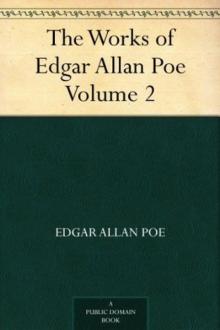 The Works of Edgar Allan Poe — Volume 2
The Works of Edgar Allan Poe — Volume 2 The Works of Edgar Allan Poe — Volume 1
The Works of Edgar Allan Poe — Volume 1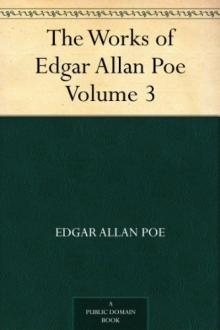 The Works of Edgar Allan Poe — Volume 3
The Works of Edgar Allan Poe — Volume 3 The Works of Edgar Allan Poe — Volume 5
The Works of Edgar Allan Poe — Volume 5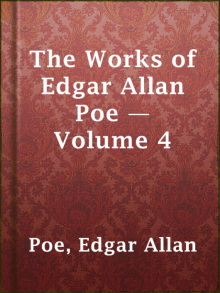 The Works of Edgar Allan Poe — Volume 4
The Works of Edgar Allan Poe — Volume 4 The Tell-Tale Heart
The Tell-Tale Heart The Raven (Penguin)
The Raven (Penguin) The Paris Mysteries
The Paris Mysteries Tales of Terror from Edgar Allan Poe
Tales of Terror from Edgar Allan Poe The Fall of the House of Usher
The Fall of the House of Usher The Golden Book of World's Greatest Mysteries
The Golden Book of World's Greatest Mysteries The Narrative of Arthur Gordon Pym of Nantucket
The Narrative of Arthur Gordon Pym of Nantucket Ligeia
Ligeia The Landscape Garden
The Landscape Garden Complete Tales & Poems
Complete Tales & Poems Great Tales and Poems of Edgar Allan Poe
Great Tales and Poems of Edgar Allan Poe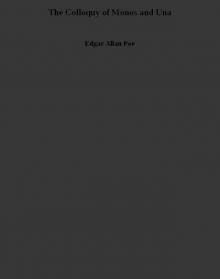 The Colloquy of Monos and Una
The Colloquy of Monos and Una The Oblong Box
The Oblong Box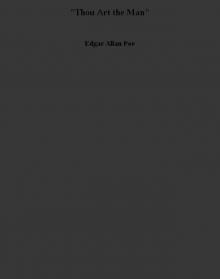 Thou Art the Man
Thou Art the Man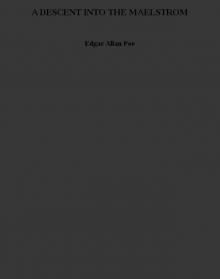 A DESCENT INTO THE MAELSTROM
A DESCENT INTO THE MAELSTROM THE MURDERS IN THE RUE MORGUE
THE MURDERS IN THE RUE MORGUE The Business Man
The Business Man The Mystery of Marie Rogêt
The Mystery of Marie Rogêt Metzengerstein
Metzengerstein The Man That Was Used Up
The Man That Was Used Up William Wilson
William Wilson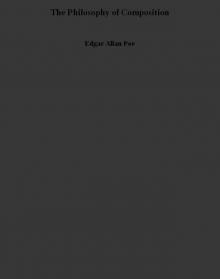 The Philosophy of Composition
The Philosophy of Composition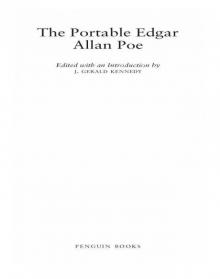 The Portable Edgar Allan Poe
The Portable Edgar Allan Poe Bon-Bon
Bon-Bon A Predicament
A Predicament The Premature Burial
The Premature Burial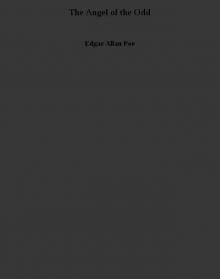 The Angel of the Odd
The Angel of the Odd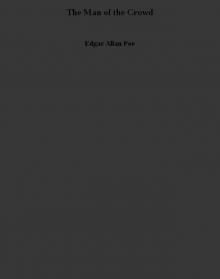 The Man of the Crowd
The Man of the Crowd Never Bet the Devil Your Head
Never Bet the Devil Your Head The Tell-Tale Heart and Other Writings
The Tell-Tale Heart and Other Writings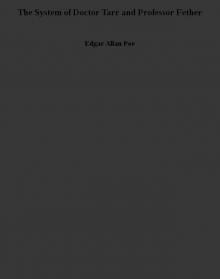 The System of Doctor Tarr and Professor Fether
The System of Doctor Tarr and Professor Fether Selected Tales (Oxford World's Classics)
Selected Tales (Oxford World's Classics) Essential Tales and Poems of Edgar Allan Poe (Barnes & Noble Classics Series)
Essential Tales and Poems of Edgar Allan Poe (Barnes & Noble Classics Series) MS. Found in a Bottle
MS. Found in a Bottle Some Words with a Mummy
Some Words with a Mummy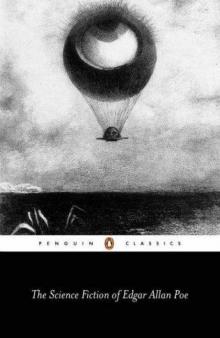 The Science Fiction of Edgar Allan Poe (Penguin Classics)
The Science Fiction of Edgar Allan Poe (Penguin Classics) King Pest
King Pest CRITICISM
CRITICISM How to Write a Blackwood Article
How to Write a Blackwood Article Mystification
Mystification Diddling Considered as One of the Exact Sciences
Diddling Considered as One of the Exact Sciences Steampunk Poe
Steampunk Poe The Literary Life of Thingum Bob, Esq.
The Literary Life of Thingum Bob, Esq. Classic Crime Collection
Classic Crime Collection Complete Stories and Poems of Edgar Allen Poe
Complete Stories and Poems of Edgar Allen Poe Berenice
Berenice The Black Cat
The Black Cat The Slender Poe Anthology
The Slender Poe Anthology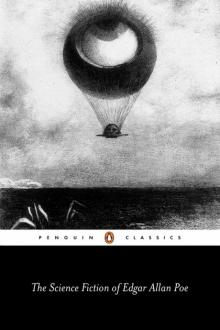 The Science Fiction of Edgar Allan Poe
The Science Fiction of Edgar Allan Poe The Assignation
The Assignation The Thousand-and-Second Tale of Scheherazade
The Thousand-and-Second Tale of Scheherazade The Raven and Other Short Stories
The Raven and Other Short Stories The Spectacles
The Spectacles Hop-Frog
Hop-Frog The Purloined Letter
The Purloined Letter Mellonta Tauta
Mellonta Tauta The Balloon-Hoax
The Balloon-Hoax Landor's Cottage
Landor's Cottage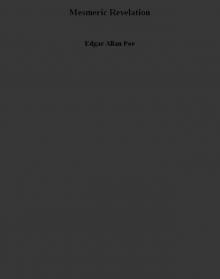 Mesmeric Revelation
Mesmeric Revelation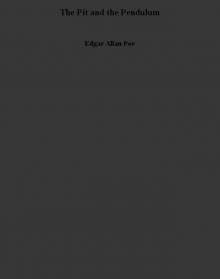 The Pit and the Pendulum
The Pit and the Pendulum